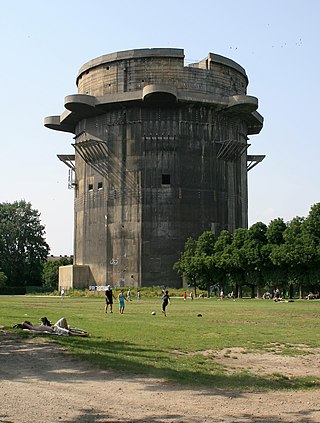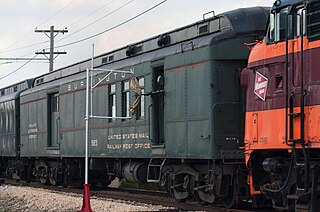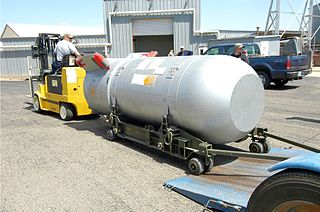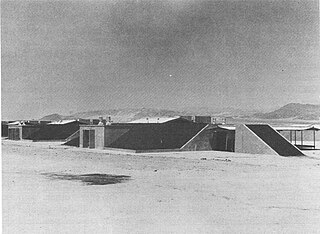
The United States Department of Energy (DOE) is an executive department of the U.S. federal government that oversees U.S. national energy policy and energy production, as well as manages the research and development of nuclear power, the military's nuclear weapons program, nuclear reactor production for the United States Navy, energy-related research, and energy conservation.

Carson County is a county located in the U.S. state of Texas. As of the 2020 census, its population was 5,807. The county seat is Panhandle. The county was founded in 1876 and later organized in 1888. It is named for Samuel Price Carson, the first secretary of state of the Republic of Texas.

A bunker is a defensive military fortification designed to protect people and valued materials from falling bombs, artillery, or other attacks. Bunkers are almost always underground, in contrast to blockhouses which are mostly above ground. They were used extensively in World War I, World War II, and the Cold War for weapons facilities, command and control centers, and storage facilities. Bunkers can also be used as protection from tornadoes.

Amarillo is a city in the U.S. state of Texas and the seat of Potter County. It is the 14th-most populous city in Texas and the largest city in the Texas Panhandle. A portion of the city extends into Randall County. The estimated population of Amarillo was 200,393 as of April 1, 2020. The Amarillo metropolitan area had an estimated population of 308,297 as of 2020.

The Atchison, Topeka and Santa Fe Railway, often referred to as the Santa Fe or AT&SF, was one of the largest Class 1 railroads in the United States.

An armoured train or armored train is a railway train protected with heavy metal plating and which often includes railway wagons armed with artillery, machine guns, and autocannons. Some also had slits used to fire small arms from the inside of the train, especially in earlier armoured trains. For the most part, they were used during the late 19th and early 20th centuries, when they offered an innovative way to quickly move large amounts of firepower into a new location. Most countries discontinued their use – road vehicles became much more powerful and offered more flexibility, train tracks proved too vulnerable to sabotage and attacks from the air, and air transportation was an even more flexible way to relocate firepower to a new location. However, there were occasional uses in the late 20th century and early 21st century Russian Federation used improvised armoured trains in the Second Chechen War (1999–2009) and the Russian invasion of Ukraine (2022–present).

In United States railroad terminology, a troop sleeper was a railroad passenger car which had been constructed to serve as something of a mobile barracks for transporting troops over distances sufficient to require overnight accommodations. This method allowed part of the trip to be made overnight, reducing the amount of transit time required and increasing travel efficiency.

In Canada and the United States, a railway post office, commonly abbreviated as RPO, was a railroad car that was normally operated in passenger service and used specifically for staff to sort mail en route, in order to speed delivery. The RPO was staffed by highly trained Railway Mail Service postal clerks, and was off-limits to the passengers on the train.

The Mk/B53 was a high-yield bunker buster thermonuclear weapon developed by the United States during the Cold War. Deployed on Strategic Air Command bombers, the B53, with a yield of 9 megatons, was the most powerful weapon in the U.S. nuclear arsenal after the last B41 nuclear bombs were retired in 1976.

Pantex is the primary United States nuclear weapons assembly and disassembly facility that aims to maintain the safety, security and reliability of the U.S. nuclear weapons stockpile. The facility is located in the Panhandle of Texas on a 16,000-acre site 17 miles (27 km) northeast of Amarillo, in Carson County, Texas. The plant is managed and operated for the United States Department of Energy (DOE) by Consolidated Nuclear Security and Sandia. Consolidated Nuclear Security, LLC (CNS) is composed of member companies Bechtel National, Inc., Leidos, Inc., Orbital ATK, Inc, and SOC LLC, with Booz Allen Hamilton, Inc. as a teaming subcontractor. CNS also operates the Y-12 National Security Complex.

The United States was the first country to manufacture nuclear weapons and is the only country to have used them in combat, with the bombings of Hiroshima and Nagasaki in World War II. Before and during the Cold War, it conducted 1,054 nuclear tests, and tested many long-range nuclear weapons delivery systems.

The Ghost Town & Calico Railway is a 3 ft narrow-gauge heritage railroad and amusement park attraction within Knott's Berry Farm, an amusement park located in Buena Park, California.

The Ferdinand Magellan is a former Pullman Company private car that served as Presidential Rail Car, U.S. Number 1 from 1943 until 1958. It is named after the Portuguese explorer. The current owner, Gold Coast Railroad Museum in Miami-Dade County, Florida, acquired it in 1959. The Ferdinand Magellan was designated a National Historic Landmark by the United States Department of the Interior, National Park Service on February 4, 1985.

The GE 45-ton switcher is a 4-axle diesel locomotive built by General Electric between 1940 and 1956.
The National Nuclear Security Administration (NNSA) is a United States federal agency responsible for safeguarding national security through the military application of nuclear science. NNSA maintains and enhances the safety, security, and effectiveness of the U.S. nuclear weapons stockpile; works to reduce the global danger from weapons of mass destruction; provides the United States Navy with safe and effective nuclear propulsion; and responds to nuclear and radiological emergencies in the United States and abroad.

Nuclear labor issues exist within the international nuclear power industry and the nuclear weapons production sector worldwide, impacting upon the lives and health of laborers, itinerant workers and their families.

The Salt Wells Pilot Plant was a facility established by the Manhattan Project at the Naval Ordnance Test Station (NOTS) at Inyokern, California, where non-nuclear explosive components of nuclear weapons were manufactured. The first explosives were melted, mixed and poured on 25 July 1945. Between 1945 and 1954, it manufactured explosive components of the Fat Man, Mark 4, Mark 5 and Mark 12 nuclear bombs. The Salt Wells Pilot Plant also helped design, equip, and train workers for the Burlington AEC Plant in Iowa and the Pantex Plant in Texas. The Salt Wells Pilot Plant closed on 30 June 1954.

A Safeguards Transporter (SGT) is a truck developed for and used by the National Nuclear Security Administration (NNSA), a semi-autonomous affiliate agency of the United States Department of Energy, for the ground transport of nuclear weapons in the contiguous United States. SGTs' trailers are known as Safe Secure Trailers (SST).
The Federal Protective Forces are the law enforcement agencies of the United States Department of Energy (DOE) responsible for the protection of Category I special nuclear material. Though officially classified as security police, they hold law enforcement status while engaged in the performance of official duties. Officers are equipped and trained to respond to serious incidents at Department of Energy facilities by armed adversaries and to reacquire stolen nuclear material. The FPFs have been described by the DOE as "elite fighting forces" designed to operate in "combat environments".

















